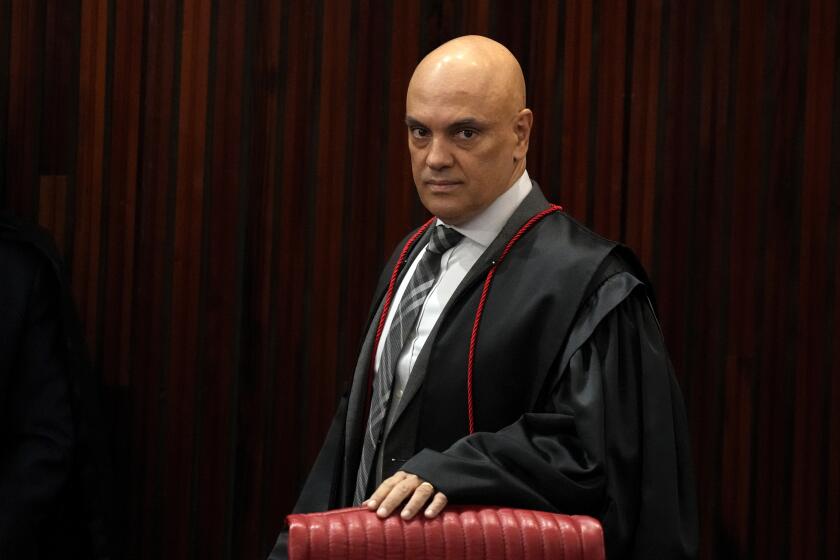High-Tech Spinoffs: Pathway to Innovation for Entrepreneurs : Ventures: Proponents say they allow employees to test their ideas in the marketplace, but some employers say they foster disloyalty.
In 1969, engineer Joel Slutzky and five co-workers quit their jobs at a large aerospace manufacturer in Azusa to form their own company to build tape machines that would enable satellites to record data in space.
Slutzky and his colleagues--eager to pursue a business that their former employer frowned upon and to create a company where going to work would be fun--founded Odetics Inc. in Anaheim. Today, the company employs 650 people and has annual sales of more than $55 million.
And in an odd twist of fate, Slutzky is teaching his employees how to do what he did more than two decades ago--leave. In a class that he calls “How to Start Your Own Business and Grow White Hair,” he advises employees on the risks and rewards of starting their own high-technology companies.
A few employees have taken his advice: one left to start a volleyball equipment shop and returned after it fizzled; another left to start a competing company that Odetics sued for stealing its trade secrets.
In the high-tech industry, Slutzky’s class may be as close as anyone comes to teaching the mysterious art of spinoffs--ventures formed by talented engineers or managers who leave an established company and launch a high-tech firm to develop their own innovations.
Some chief executives say Slutzky is teaching heresy. They say nothing could damage a high-tech firm more than to encourage budding entrepreneurs to run off with a money-making idea and perhaps steal sales and trade secrets from their former employer.
Still, the spinoff process is clearly an engine of economic growth. Just as in the entertainment industry, where TV shows such as “The Mary Tyler Moore Show” spun off the shows “Rhoda” and “Phyllis,” Southern California is studded with high-tech spinoffs that had their origins because of ambitious, risk-taking engineers like Slutzky.
Examples of spinoffs abound in the Southland:
* In Orange County, AST Research Inc., a personal computer maker in Irvine that reported sales this year of $688.5 million, traces some of its founders and top engineers to Computer Automation, one of the first minicomputer makers in the 1970s.
* In the San Fernando Valley, Ampex Corp. spun off a computer products maker called Pertech, which begat Micropolis Corp., a $400-million disk drive manufacturer in Chatsworth.
* In El Segundo, Xerox Corp.’s Data Systems unit spawned Silicon Systems, a custom semiconductor chip manufacturer in Tustin. A unit of Citicorp spun off Teradata Corp., a Los Angeles database company with $225 million in sales.
While spinoffs have been a longstanding practice of corporate America, it is an issue of some dispute in high-tech circles. Proponents of the spinoff process say it allows talented employees to test their ideas in the marketplace, ideas or technologies often ignored by bigger companies.
But some employers hate it because it fosters disloyalty and has a parasitic effect on an established company’s ability to compete.
“The great irony is the people who are complaining most about spinoffs are the chief executives who got started in the same way,” said Jeffry Timmons, professor of venture economics at the Harvard Business School.
More and more, executives are learning to live with the reality of spinoffs. The process suits the high-tech industry so well because of the quick pace of innovation and the wealth of opportunities for new product ideas, Timmons said.
Entrepreneurship peaks in times of technological upheaval, as in the early 1980s when scores of firms formed to take advantage of the personal computer revolution. The availability of venture capital--an important source of financing for start-up companies--can also affect the pace of spinoffs.
Spinoffs take on added importance in a recession. While big companies lay off people in a recession, smaller companies often continue to generate new jobs, said Ralph Sabin, manager of high-tech and manufacturing services for the Ernst & Young accounting firm in Southern California.
“The established companies that encourage spinoffs are making a real contribution to the process by giving people experience that they can use to start their own companies,” said Judith Larsen, research director at San Jose-based market research firm Dataquest Inc.
The spinoff capital of the world is Northern California’s Silicon Valley. The region owes its existence to a chain reaction of businesses spun off from two now-defunct companies: Shockley Semiconductor Laboratory, founded by William Shockley, the inventor of the transistor, and Fairchild Semiconductor, formed by eight former Shockley engineers. By one count, more than 120 companies trace their roots to the two firms.
Brilliant engineers, such as Robert Noyce, co-inventor of the integrated circuit, left Shockley and Fairchild to start their own companies in the 1960s and 1970s. They put Silicon Valley on the map by spawning such electronics giants as Intel Corp., National Semiconductor Corp. and Advanced Micro Devices.
The spinoffs were fueled by young professionals in big cities who would go wherever the opportunities were. Instead of being fiercely loyal to a single company, they owed their allegiance to technology itself.
In Southern California, particularly Orange County, a smaller concentration of technology companies clustered around the Southland’s big defense plants. Unlike Silicon Valley, though, the Southland’s technology firms descended from a variety of different firms. A few family trees trace back to the 1960s to companies such as Microdata, Decision Control, Scientific Data Systems, Ampex Corp. and Pertech Corp.
In some ways, starting a company is easier now. Southern California has built an infrastructure of support for start-ups, said Thomas O. Gephardt, founder of the Ventana International venture capital firm in Irvine.
Despite the sluggish economy, money is still flowing freely. Venture capitalists invested $251.2 million in 114 firms in Southern California in 1990, about 10% of the amount invested nationwide, according to Venture Economics, a Boston research firm. That level is below a peak of $577.7 million invested in 193 companies in 1987, but it is well above the $61.7 million invested in 45 companies in 1980.
But Timmons believes that the number of new technology spinoffs in Southern California may be shrinking as high-tech businesses mature and the pace of innovation slows.
Corporations are also reining in employee’s freedom to scoot with an idea and compete with his former company. Fed up with high turnover, Fairchild Semiconductor was one of the first firms to institute a no-return policy for employees who left to start their own companies.
Other firms have required executives and other key employees to sign so-called golden handcuff agreements that restrict their involvement with competitive businesses for a certain period or impose financial penalties if they quit the firm early.
Tiffany Haugen, director of UC Irvine’s program for innovation and new ventures, said large companies often decide to spin off technology instead of investing the money to develop it themselves. By spinning off technologies, the larger firm can generate cash for the short term and preserve the possibility of reacquiring the technology when it is ready for the market.
“With the trend in down-sizing, it can be more cost-effective for companies to form some kind of joint venture,” Haugen said. “It reduces the company’s financial risk.”
Others have sought for ways to make room for entrepreneurs within their companies.
Stuart Mabon, chief executive of disk-drive maker Micropolis, has tried within his company to create an innovative atmosphere that will satisfy would-be entrepreneurs. He has formed small subsidiaries in which he puts several engineers in charge and offers financial incentives when they meet certain goals.
This way the research will stay within Micropolis and the engineers need not risk their careers in a start-up. The method is similar to the way many Japanese companies promote internal entrepreneurism.
“It isn’t always as successful as a true spinoff,” Mabon acknowledged, partly because the financial rewards are limited.
For some engineers, only a clean break will do. They throw their comfortable jobs and caution to the wind and enjoy the freedom of making their own decisions.
Bob Lowry, who has started or helped create 23 spinoffs and is chief executive of Technology Marketing Inc., a computer products firm in Irvine, said he likes the environment of a small company. “When it gets to where I don’t know anybody by first names or families, it’s time for me to go and turn it over to professional management,” he said.
For others, frustration with management is the major motivation for starting a new company.
In 1966, Varian Associates, then a large instruments maker in Palo Alto, acquired a computer-memory components manufacturer called Decision Control Inc. in Costa Mesa. The Silicon Valley firm sent an executive with no knowledge of computing to run the division. Within a year, more than a dozen engineers were so fed up that they quit to form separate companies, including Computer Automation, Technology Marketing Inc. and General Automation.
“It was like stirring up a covey of quail. We all flew the coop,” said David Methvin, founder of Computer Automation and now president of Davin Computer Corp. in Irvine.
Sometimes, the motivation for a spinoff comes from an entrepreneur’s personal urge to prove that the first business success wasn’t a fluke.
Albert Wong feels that way. He formed a new computer company, Amkly Systems Inc., in 1989, a year after he left AST Research, the computer maker he co-founded in 1979 with Safi Qureshey and Thomas Yuen.
AST, which traces its origins to Computer Automation, is perhaps Southern California’s most successful high-tech spinoff. That success has created an emotional burden to succeed in the second venture, Wong said.
“I love AST and didn’t want to compete with them immediately after I left,” said Wong, who hired a dozen ex-AST employees, mostly after they had already left the former company. “But I felt there was a new challenge for me.”
More to Read
Inside the business of entertainment
The Wide Shot brings you news, analysis and insights on everything from streaming wars to production — and what it all means for the future.
You may occasionally receive promotional content from the Los Angeles Times.






